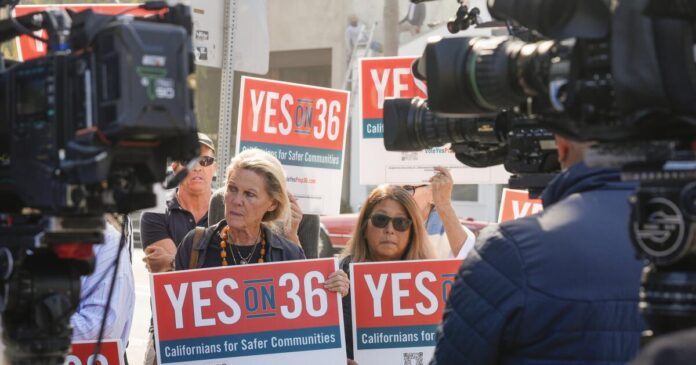California voters decided this week to roll back criminal justice reforms and appeared to be ousting progressive prosecutors in Los Angeles and Alameda counties, effectively reversing decisions they made as recently as 2020 and 2022.
Voters overwhelmingly passed Proposition 36, which will allow some misdemeanor theft and drug possession to be treated as felonies, with longer prison and jail sentences. L.A. County voters rejected a second term for Dist. Atty. George Gascón, electing former federal prosecutor Nathan Hochman, who promised to revoke some of the incumbent’s reforms and prosecute defendants to the fullest extent of the law. And in Alameda County, early returns were favoring a recall of Dist. Atty. Pamela Price, a civil rights lawyer elected in 2022 on promises to reduce incarceration, expand restorative justice programs and prosecute police officers for misconduct.
Headlines and pundits will undoubtedly declare this the end of the criminal justice reform era. But that would be too hasty. While the approval of Proposition 36 and the loss of two reform-minded district attorneys are setbacks, a broader outlook suggests public opinion still favors a more even-handed approach to criminal justice and opportunities for rehabilitation.
Indeed, the proponents of Proposition 36, including the mayors of San José, San Francisco and San Diego, described it as a “mass treatment” measure to address “chronic homelessness, addiction and despair.” The initiative creates a treatment-mandated felony for a third possession charge, meaning the accused would have to complete court-supervised drug treatment or be sentenced to a multiyear jail or prison term. That language was designed to appeal to voters who don’t want a return to the lock-’em-up era of the 1990s, which led to mass incarceration.
The problem is that Proposition 36 doesn’t deliver treatment. It provides no funding for substance abuse care, and 22 of California’s counties provide no residential addiction treatment. And because Proposition 36 increases penalties for certain offenses, more people will end up in jails and prisons, costing California hundreds of millions of dollars more a year. That’s money that could — and should — be spent on crime prevention and rehabilitation programs, including substance abuse treatment.
Both Gascón and Price were elected in the wake of the George Floyd protests, when the public was crying out for systemic changes to the criminal justice system. Both sought to recalibrate their offices’ use of prosecutorial power by declining to charge youths as adults and refraining from seeking the maximum penalty in every case.
But both were battered by relentless opposition from law enforcement and traditional tough-on-crime prosecutors, and they were unfairly blamed for increases in crime. But the two also made missteps as administrators and politicians. That may be why they were ousted even as progressive prosecutors in Contra Costa and Santa Clara counties were recently reelected.
Even as Hochman was pledging to reverse Gascón’s “social experiments,” he was pitching himself as the prosecutor who would do a more responsible, effective job of implementing the reform policies voters support. Now we’ll see if he abides by that commitment.
While there’s underlying support for a more fair, humane criminal justice system, it would be irresponsible to ignore the message voters sent in this election: Californians are concerned about public safety. They are frustrated with the sense of disorder they see in brazen smash-and-grab robberies and stores locking up everyday goods because of retail theft. Property crime statewide is low compared with the last few decades, according to the Public Policy Institute of California, but it increased in 2023 in some of the state’s most populous counties, including Los Angeles and Alameda. Violent crime statewide rose slightly last year and is still higher than it was before the COVID-19 pandemic, though it’s still much lower than in the 1980s and ‘90s.
Public officials should make more of an effort to understand why their constituents feel unsafe. They should respond with appropriate, practical solutions, such as early intervention to direct low-level offenders to treatment, housing and services so they don’t end up facing more serious charges and prison time.
In the absence of such leadership, special interest groups will step in with measures that fall back on stiff punishment and mass incarceration, as Proposition 36 does. California has done that already and paid the price — in billions of dollars spent on prisons and families broken up by long sentences. Let’s not make the same mistake again.



